Crystal Indentation Hardness
Abstract
:1. Introduction
2. Continuous Indentation Testing
2.1. Continuous Load–Deformation Measurements
2.2. Crystal Plasticity
2.3. Crystal Cracking
2.3.1. Crack Formation
2.3.2. Indentation Fracture Mechanics
3. Applications
3.1. Polycrystals, Polyphases and Amorphous Phases
3.2. Hardness as a Test Probe
4. Summary
Conflicts of Interest
References
- Walley, S.M. Review: Historical origins of indentation hardness testing. Mater. Sci. Technol. 2012, 28, 1028–1044. [Google Scholar] [CrossRef]
- Tabor, D. The Hardness of Metals; Clarendon Press: Oxford, UK, 1951. [Google Scholar]
- Westbrook, J.H.; Conrad, H. (Eds.) The Science of Hardness Testing and Its Research Applications; American Society for Metals: Metals Park, OH, USA, 1973.
- Armstrong, R.W.; Elban, W.L.; Walley, S.M. Elastic, plastic and cracking aspects of the hardness of materials. Int. J. Mod. Phys. B 2013, 28, 1330004. [Google Scholar] [CrossRef]
- Armstrong, R.W.; Elban, W.L. Review: Hardness properties across multi-scales of applied loads and material structures. Mater. Sci. Technol. 2012, 28, 1060–1071. [Google Scholar] [CrossRef]
- Pathak, S.; Kalidindi, S.R. Spherical nanoindentation stress-strain curves. Mater. Sci. Eng. R 2015, 91, 1–36. [Google Scholar] [CrossRef]
- Lu, C.; Mai, Y.W.; Tam, P.L.; Shen, Y.G. Nanoindentation-induced elastic-plastic transition and size effect in α-Al2O3 (0001). Philos. Mag. Letts. 2007, 87, 409–415. [Google Scholar] [CrossRef]
- Dub, S.N.; Braxhkin, V.V.; Novikov, N.V.; Tolmachova, G.N.; Litvin, P.M.; Litagina, L.M.; Dyuzheva, T.I. Comparative Studies of Mechanical Properties of Stishovite and Sapphire Single Crystals by Nanoindentation. (RU) J. Superhard Mater. 2010, 32, 406–414. [Google Scholar] [CrossRef]
- Ferrante, L., Jr.; Armstrong, R.W.; Thadhani, N.N. Elastic/plastic deformation behavior in a continuous ball indentation test. Mater. Sci. Eng. A 2004, 371, 251–255. [Google Scholar] [CrossRef]
- Yoshida, M.; Sumomogi, T.; Endo, T.; Maeta, H.; Kino, T. Nanoscale Evaluation of Strength and Deformation Properties of Ultrahigh-Purity Aluminum. (JPN) Mater. Trans. 2007, 48, 1–5. [Google Scholar] [CrossRef]
- Solhjoo, S.; Vakis, A.I. Continuum mechanics at the atomic scale: Insights into non-adhesive contacts using molecular dynamics simulations. J. Appl. Phys. 2016, 120, 215102. [Google Scholar] [CrossRef]
- Oliver, W.C.; Pharr, G.M. An improved technique for determining hardness and elastic modulus using load and displacement sensing indentation experiments. J. Mater. Res. 1992, 7, 1564–1583. [Google Scholar] [CrossRef]
- Alcala, J.; Dalman, R.; Franke, O.; Biener, M.; Biener, J.; Hodge, A. Planar defect nucleation and annihilation mechanisms in nanocontact plasticity of metal surfaces. Phys. Rev. Lett. 2010, 109, 075502. [Google Scholar] [CrossRef] [PubMed]
- Ruestes, C.J.; Sukowski, A.; Tang, Y.; Tramontina, D.R.; Erhart, P.; Remington, B.A.; Urbassek, H.M.; Meyers, M.A.; Bringa, E.M. Atomistic simulation of tantalum nanoindentation: Effects of indenter diameter, penetration velocity, and interatomic potentials on defect mechanisms and evolution. Mater. Sci. Eng. A 2014, 613, 390–403. [Google Scholar] [CrossRef]
- Alhafez, I.A.; Ruestes, C.J.; Gao, Y.; Urbassek, H.M. Nanoindentation of hcp metals: A comparative simulation study of the evolution of dislocation networks. Nanotechnology 2016, 27, 045706. [Google Scholar] [CrossRef] [PubMed]
- Gao, F. Theoretical model of hardness anisotropy in brittle materials. J. Appl. Phys. 2012, 112, 023506. [Google Scholar] [CrossRef]
- Elban, W.L.; Armstrong, R.W. Plastic anisotropy and cracking at hardness impressions in single crystal ammonium perchlorate. Acta Mater. 1998, 46, 6041–6052. [Google Scholar] [CrossRef]
- Armstrong, R.W.; Ruff, A.W.; Shin, H. Elastic, plastic and cracking indentation behavior of silicon crystals. Mater. Sci. Eng. A 1996, 209, 91–96. [Google Scholar] [CrossRef]
- Wan, H.; Shen, Y.; Chen, Q.; Chen, Y. A plastic damage model for finite element analysis of cracking of silicon under indentation. J. Mater. Res. 2010, 25, 2224–2237. [Google Scholar] [CrossRef]
- Vodenitcharaova, T.; Borrero-López, O.; Hoffman, M. Mechanics prediction of the fracture pattern on scratching wafers of single crystal silicon. Acta Mater. 2012, 60, 4448–4460. [Google Scholar] [CrossRef]
- Egart, M.; Janković, B.; Srčič, S. Application of instrumented nanoindentation in preformulation studies of pharmaceutical active ingredients and excipients. Acta Pharm. 2016, 66, 303–330. [Google Scholar] [CrossRef] [PubMed]
- Mohamed, R.M.; Mishra, M.K.; Al-Harbi, L.M.; Al-Ghamdi, M.S.; Asiri, A.M.; Reddy, C.M.; Ramamurty, U. Temperature Dependence of Mechanical Properties in Molecular Crystals. Cryst. Growth Des. 2015, 15, 2474–2479. [Google Scholar] [CrossRef]
- Raut, D.; Kiran, M.S.R.N.; Mishra, M.K.; Asiri, A.M.; Ramamurty, U. On the loading rate sensitivity of plastic deformation in molecular crystals. CrystEngComm 2016, 18, 3551–3555. [Google Scholar] [CrossRef]
- Weingarten, N.S.; Sausa, R.C. Nanomechanics of RDX Single Crystals by Force-Displacement Measurements and Molecular Dynamics Simulations. J. Phys. Chem. A 2015, 119, 9338–9351. [Google Scholar] [CrossRef] [PubMed]
- Voloshin, A.V.; Dolzhenkova, E.F.; Litvinov, L.A. Anisotropy of Deformation and Fracture Processes in Sapphire Surface. (RU) J. Superhard Mater. 2015, 37, 341–345. [Google Scholar] [CrossRef]
- Bull, S.J.; Moharrami, N.; Hainsworth, S.V.; Page, T.F. The origins of chemomechanical effects in the low-load indentation hardness and tribology of ceramic materials. J. Mater. Sci. 2016, 51, 107–125. [Google Scholar] [CrossRef]
- Juday, R.; Silva, E.M.; Huang, J.Y.; Caldas, P.G.; Prioli, R.; Ponce, F.A. Strain-related optical properties of ZnO crystals due to nanoindentation on various surface orientations. J. Appl. Phys. 2013, 113, 183511. [Google Scholar] [CrossRef]
- Seok, M.-Y.; Choi, I.-C.; Moon, J.; Kim, S.; Ramamurty, U.; Jang, J.-I. Estimation of the Hall–Petch strengthening coefficient of steels through nanoindentation. Scr. Mater. 2014, 87, 49–52. [Google Scholar] [CrossRef]
- Soer, W.A.; Aifantis, K.E.; de Hosson, J.T.M. Incipient plasticity during nanoindentation at grain boundaries in body-centered cubic metals. Acta Mater. 2005, 53, 4665–4676. [Google Scholar] [CrossRef]
- Guo, Y.; Collins, D.M.; Tarleton, E.; Hofmann, F.; Tischler, J.; Liu, W.; Xu, R.; Wilkinson, A.J.; Britton, T.B. Measurements of stress fields near a grain boundary: Exploring blocked arrays of dislocations in 3D. Acta Mater. 2015, 96, 229–236. [Google Scholar] [CrossRef]
- Kareer, A.; Hou, X.D.; Jennett, N.M.; Hainsworth, S.V. The interaction between lateral size effect and grain size when scratching polycrystalline copper using a Berkovich indenter. Philos. Mag. 2016, 96, 3414–3429. [Google Scholar] [CrossRef]
- Xu, B.; Tian, Y. Ultrahardness: Measurement and Enhancement. J. Phys. Chem. 2015, 119, 5633–5638. [Google Scholar] [CrossRef]
- Li, B.; Sun, H.; Chen, C. Large indentation strain stiffening in nanotwinned cubic boron nitride. Nat. Commun. 2014, 5, 4965–4971. [Google Scholar] [CrossRef] [PubMed]
- Lee, H.C.; Gurland, J. Hardness and deformation of cemented tungsten carbide. Mater. Sci. Eng. 1978, 33, 125–133. [Google Scholar] [CrossRef]
- Roa, J.J.; Jiménez-Pique, E.; Verge, C.; Tarragό, J.M.; Mateo, A.; Llanes, L. Intrinsic hardness of constitutive phase in WC–Co composites: Nanoindentation testing, statistical analysis, WC crystal orientation effects and flow stress for the constrained metallic binder. J. Eur. Ceram. Soc. 2015, 35, 3419–3425. [Google Scholar] [CrossRef]
- Roa, J.J.; Jiménez-Pique, E.; Tarragό, J.M.; Sandoval, D.A.; Mateo, A.; Fair, J.; Llanes, L. Hall–Petch strengthening of the constrained metallic binder in WC–Co cemented carbides: Experimental assessment by means of massive nanoindentation and statistical analysis. Mater. Sci. Eng. A 2016, 676, 487–491. [Google Scholar] [CrossRef]
- Zhang, M.; Wang, Y.J.; Dai, L.H. Correlation between strain rate sensitivity and α relaxation of metallic glasses. AIP Adv. 2016, 6, 075022. [Google Scholar] [CrossRef]
- Gilman, J.J. Hardness—A Strength Microprobe. In The Science of Hardness Testing and Its Research Applications; Westbrook, J.H., Conrad, H., Eds.; American Society for Metals: Metals Park, OH, USA, 1973; pp. 51–74. [Google Scholar]
- Göring, G.; Dietrich, P.-I.; Blaicher, M.; Sharma, S.; Korvink, J.G.; Schimmel, T.; Koos, C.; Hölscher, H. Tailored probes for atomic force microscopy fabricated by two-photon polymerization. Appl. Phys. Lett. 2016, 109, 063101. [Google Scholar] [CrossRef]
- Tang, B.T.F.; Zhou, Y.; Zabev, T. Reduced hardening of nanocrystalline nickel under multiaxial indentation loading. J. Mater. Res. 2015, 30, 3528–3541. [Google Scholar] [CrossRef]
- Wang, J.Q.; Perepezko, J.H. Focus: Nucleation kinetics of shear bands in metallic glass. J. Chem. Phys. 2016, 145, 211803. [Google Scholar] [CrossRef]
- Samanta, A.; Weinan, E. Interfacial diffusion aided deformation during nanoindentation. AIP Adv. 2016, 6, 075002. [Google Scholar] [CrossRef]
- Lin, P.H.; Du, X.H.; Chen, Y.H.; Chen, H.C.; Huang, J.C. Nano-scaled diffusional or dislocation creep analysis of single-crystal ZnO. AIP Adv. 2016, 6, 095125. [Google Scholar] [CrossRef]
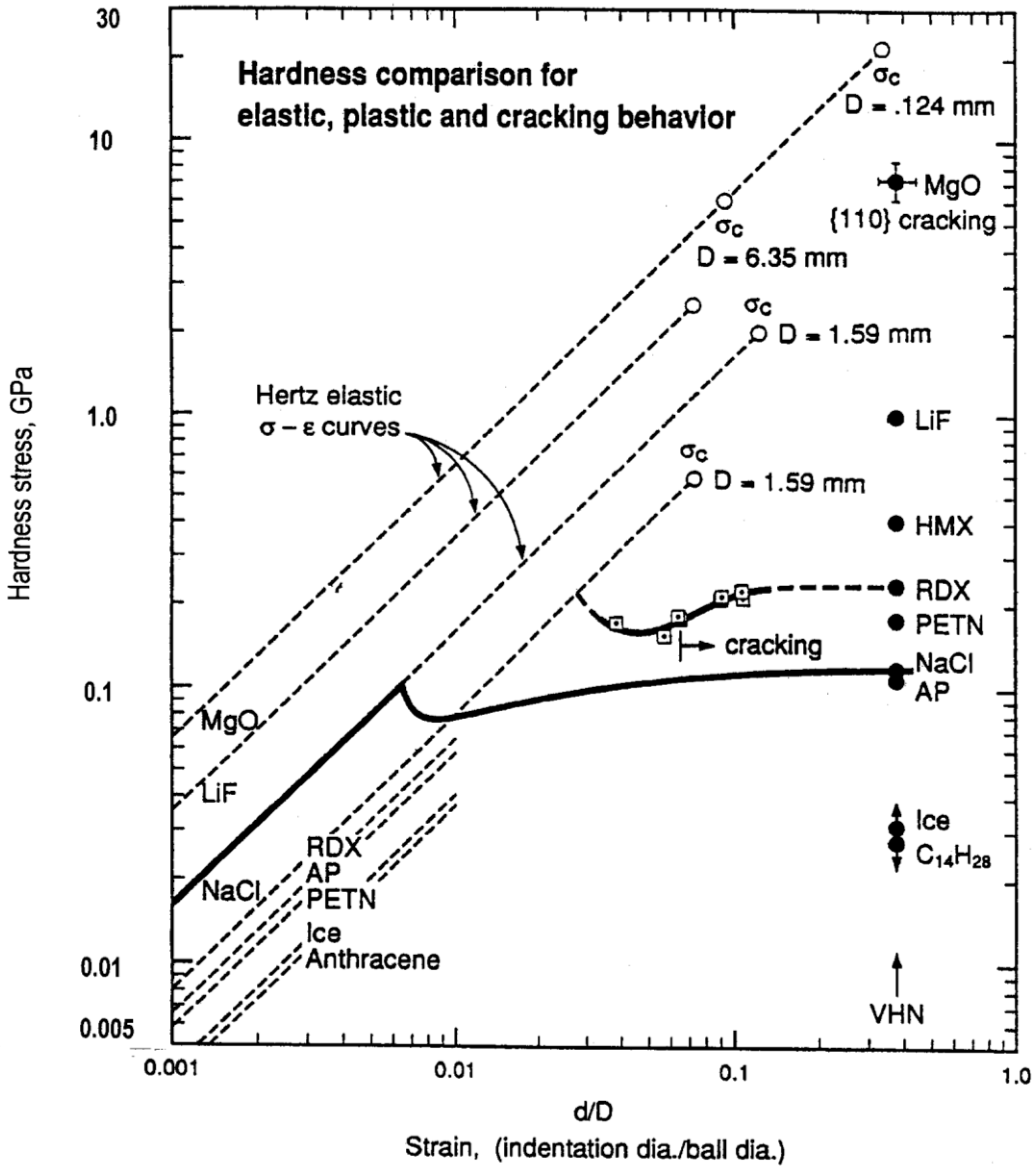

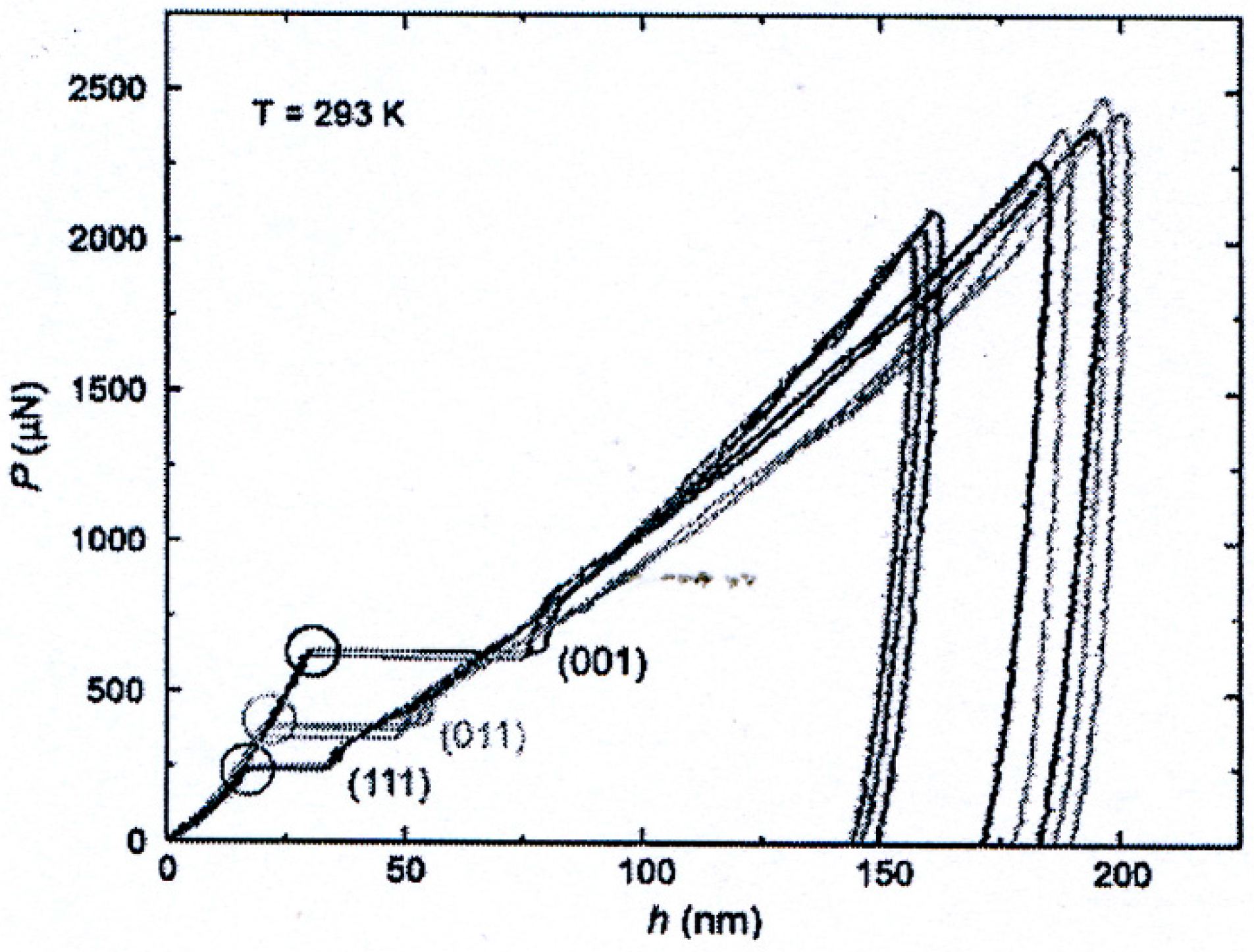
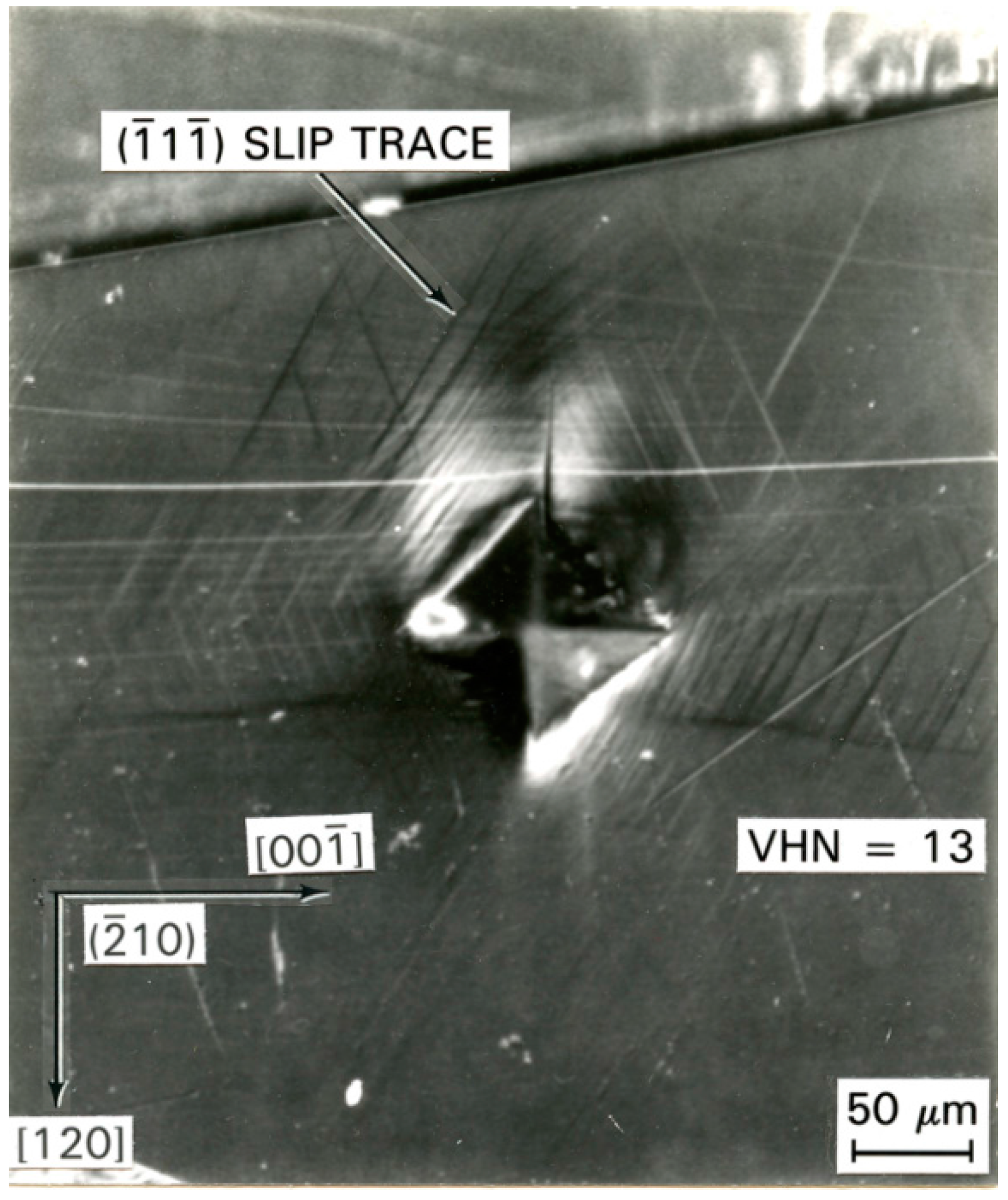
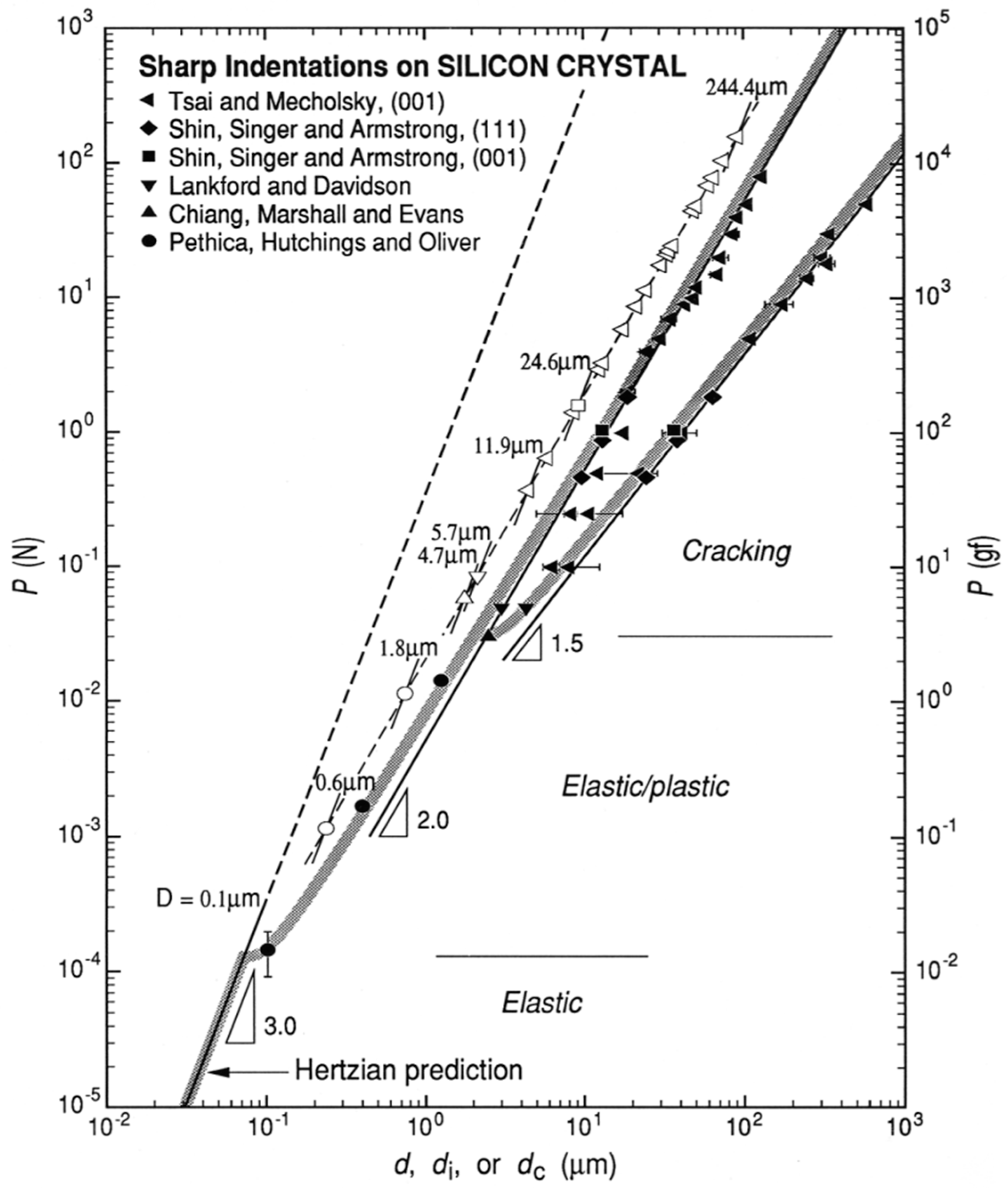
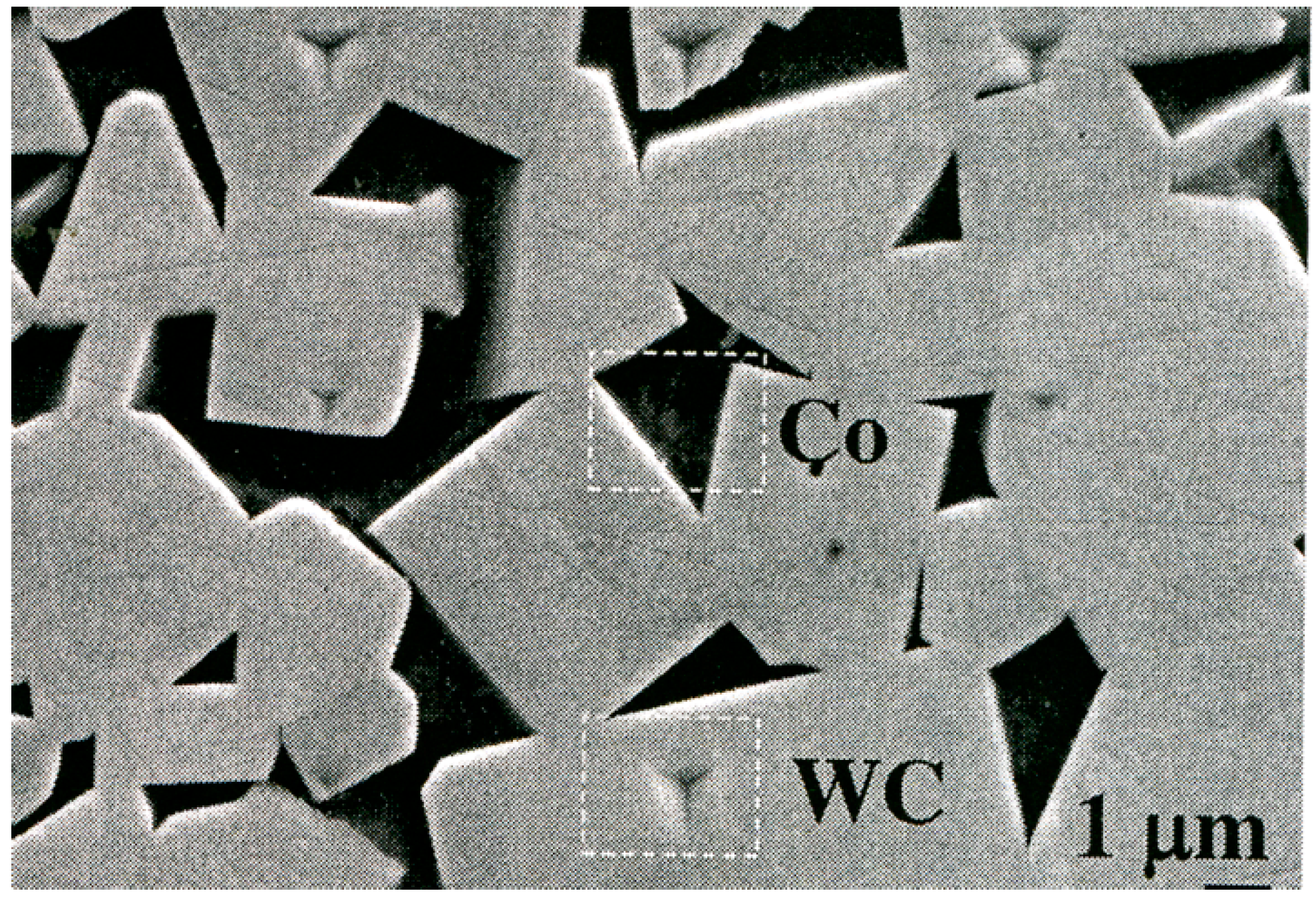
© 2017 by the authors; licensee MDPI, Basel, Switzerland. This article is an open access article distributed under the terms and conditions of the Creative Commons Attribution (CC-BY) license (http://creativecommons.org/licenses/by/4.0/).
Share and Cite
Armstrong, R.W.; Walley, S.M.; Elban, W.L. Crystal Indentation Hardness. Crystals 2017, 7, 21. https://doi.org/10.3390/cryst7010021
Armstrong RW, Walley SM, Elban WL. Crystal Indentation Hardness. Crystals. 2017; 7(1):21. https://doi.org/10.3390/cryst7010021
Chicago/Turabian StyleArmstrong, Ronald W., Stephen M. Walley, and Wayne L. Elban. 2017. "Crystal Indentation Hardness" Crystals 7, no. 1: 21. https://doi.org/10.3390/cryst7010021





